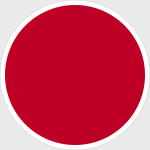Dragon DRR60435 Imperial Japanese Army Late Production Type 97 "Chi-Ha" Medium Tank - 14th Independent Tank Company, Jeju-Do, Korea, 1945 (1:72 Scale)
"American planners took no note [initially] of the possibility that [non-U.S.] Allied ground troops might participate in the invasion of the Kanto Plain. The published plans indicated that assault, followup, and reserve units would all come from U.S. forces. [However, as] the Coronet plans were being refined during the [northern] summer of 1945, all the major Allied countries offered ground forces, and a debate developed at the highest levels of command over the size, mission, equipment, and support of these contingents."
- U.S. historian John Ray Skates discussing the military's plans for Operation Olympic, the Invasion of Kyushu;, Japan
 During the development of the Type 97 Medium Tank, The Japanese decided to call it "Chi" as a code name of sorts for the medium tank. Because the Type 97 was the third medium tank created (the previous two being the Type 89 "Ko" and "Otsu"), the Type 97 was named as Chi-Ha (Ha is the third letter of the Japanese alphabet). Note that Chi had not been used before Type 97. Before that, the code name of the Japanese tank is a simple sequential name like Yi-Go, Ha-Go.
From 1942 onwards, the Type 97 tank was re-armed with the high velocity 47mm cannon and became known as the Shinhoto "Chi-Ha" (The term Shinhoto means "new turret"). Of course, mounting a larger cannon required a larger turret design than was originally envisaged for earlier versions of the Type 97. All things considered, this was probably the best designed tank that Japan fielded right up to the end of the war. Nevertheless, it was no match for their Allied counterparts, particularly the M4 Sherman series, which it was oftentimes forced to face.
During the development of the Type 97 Medium Tank, The Japanese decided to call it "Chi" as a code name of sorts for the medium tank. Because the Type 97 was the third medium tank created (the previous two being the Type 89 "Ko" and "Otsu"), the Type 97 was named as Chi-Ha (Ha is the third letter of the Japanese alphabet). Note that Chi had not been used before Type 97. Before that, the code name of the Japanese tank is a simple sequential name like Yi-Go, Ha-Go.
From 1942 onwards, the Type 97 tank was re-armed with the high velocity 47mm cannon and became known as the Shinhoto "Chi-Ha" (The term Shinhoto means "new turret"). Of course, mounting a larger cannon required a larger turret design than was originally envisaged for earlier versions of the Type 97. All things considered, this was probably the best designed tank that Japan fielded right up to the end of the war. Nevertheless, it was no match for their Allied counterparts, particularly the M4 Sherman series, which it was oftentimes forced to face.
Dragon Armor is adding to its range of Japanese subjects in its much sought-after 1/72 scale range. The new arrival is a Type 97 Chi-Ha tank, Japans most widely produced medium tank of WWII. Boasting a short-barreled 57mm main gun and two Type 97 machine guns, this tank was intended to serve as an up-scaled version of the Type 95 for infantry support. Armor protection was modest on this vehicle. A total of 2,123 tanks were produced from 1938-43, although 930 of these were of the improved Type 97 Kai version featuring a higher-velocity 47mm gun. The tank could move at a speed of 38km/h.
The Chi-Ha was used in combat in Manchuria and China, as well as fighting against the Allies. Indeed one of the largest tank attacks of the Pacific theater occurred at Saipan in 1944 when 36 Type 97 tanks of the IJAs 9th Tank Regiment conducted an all-out attack against US Marines. Dragon Armors model portrays one such Type 97 Chi-Ha medium tank that participated in this ferocious battle on Saipan. The colorful camouflage paint scheme is particularly well rendered. The accurate markings such as Japanese characters on the side of the hull, national flag emblems, prominent turret images and rear number plate. These markings are very interesting, especially when compared with contemporary Allied or German markings. Japanese tanks of WWII dont usually gain the attention that equivalent German ones do, so this model allows collectors to get acquainted with a very important Japanese tank design.
Sold Out!
Dimensions:
Length: 4-inches
Width: 1-inch
Release Date: November 2011
 Historical Account: "The Japanese Imperial Period" - Korea was under Japanese rule as part of Japan's 35-year imperialist expansion (August 22nd, 1910 to August 15th, 1945). Japanese rule formally ended on September 2nd, 1945, upon the Japanese defeat in World War II that year.
Historical Account: "The Japanese Imperial Period" - Korea was under Japanese rule as part of Japan's 35-year imperialist expansion (August 22nd, 1910 to August 15th, 1945). Japanese rule formally ended on September 2nd, 1945, upon the Japanese defeat in World War II that year.
Korea was occupied and declared a Japanese protectorate in the 1905 Eulsa Treaty, and officially annexed in 1910 through the annexation treaty. Japan's involvement in the region began with the 1876 Treaty of Ganghwa during the Joseon Korea. The 1905 and 1910 treaties were eventually declared "null and void" by both Japan and South Korea in 1965.
In Korea, the period is usually described as the "Japanese Imperial Period". Other terms include "Japanese forced occupation" or "Wae (Japanese) administration".





 Japanese Type 97 Medium Tank
Japanese Type 97 Medium Tank 



 Japanese Late Production Type 97 "Chi-Ha" Medium T
Japanese Late Production Type 97 "Chi-Ha" Medium T